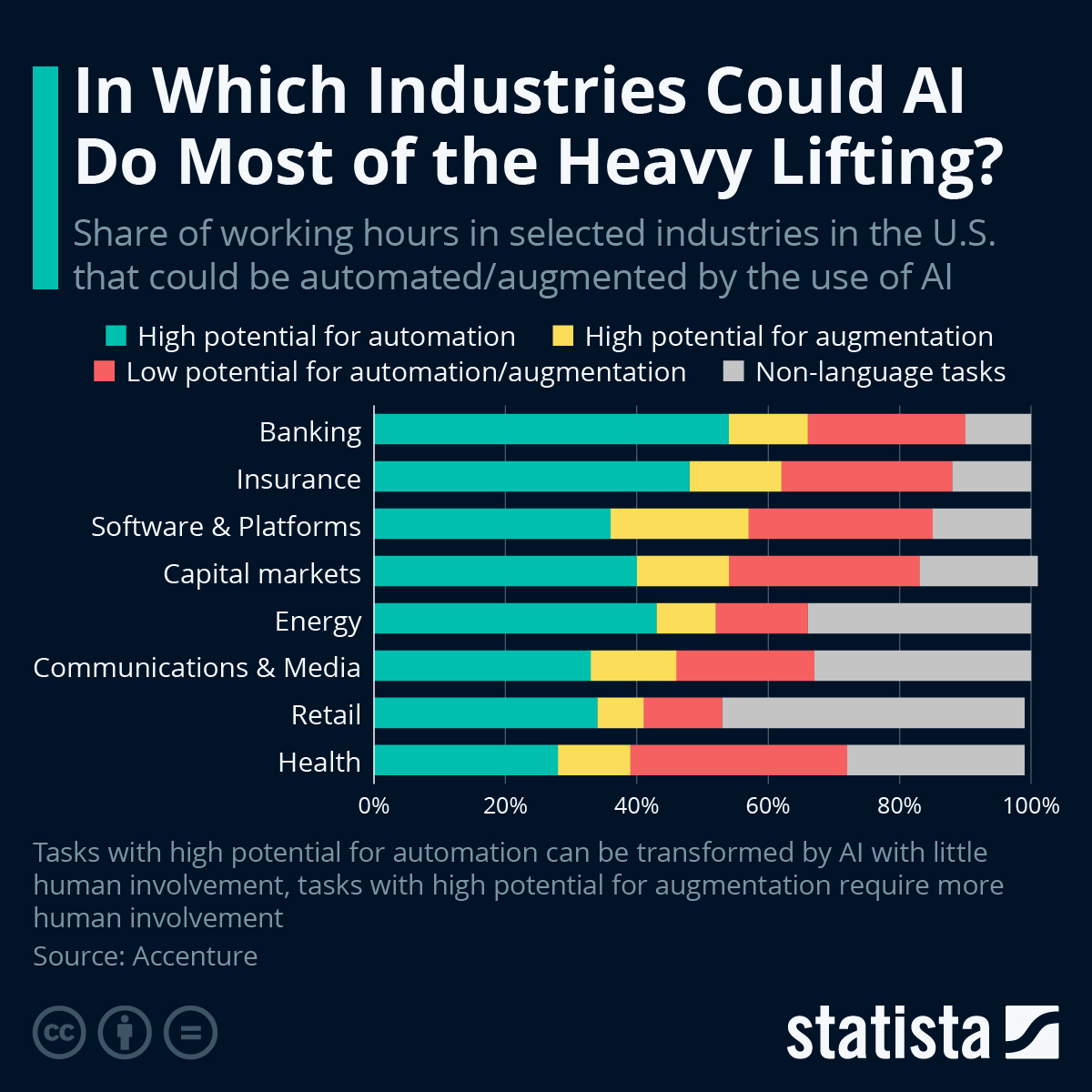
Ever since the meteoric rise of ChatGPT and other large language models, one of the most pressing questions on many people’s minds – well aside from whether AI will end humanity – has been: “Will AI eventually take my job?”
And while there is no clear answer to this question – after all, it’s hard to foresee how quickly AI will improve from here – it looks like large language models will at least have a major impact on HOW many people work.
As Statista's Felix Richter details below, according to Accenture research based on data from the Occupational Information Network, the U.S. Department of Labor and the Bureau of Labor Statistics, 40 percent of all hours worked in the United States in 2021 can be impacted by large language models such as ChatGPT, whether through automation (little human involvement required) or augmentation (more human involvement required). Why is that? Accenture found that tasks related to language account for 62 percent of total worked time in the U.S. and that 65 percent of those tasks have a high potential to be automated or augmented by AI, or more specifically by large language models.
Thankfully, that doesn’t mean that machines will simply replace humans, as many tasks will still require human involvement and new tasks will emerge. "Success with generative AI requires an equal attention on people and training as it does on technology," Accenture says, adding that it will be essential to teach people how to work effectively with AI-infused processes. Moreover, new roles will emerge, with prompt engineers, AI editors and AI quality controllers just some of the examples for new career opportunities.
The following chart shows which industries involve the most tasks that can be automated or augmented by AI, with banking and insurance on top of the ranking.
You will find more infographics at Statista
Accenture found that 66 percent of hours worked in the banking sector have high potential to be transformed by AI, versus an industry average of 40 percent.
At the other end of the scale, the chemical and natural resources sectors are tipped to be least impacted by AI, with the majority of working time in these industries dedicated to non-language-related tasks.
Ever since the meteoric rise of ChatGPT and other large language models, one of the most pressing questions on many people’s minds – well aside from whether AI will end humanity – has been: “Will AI eventually take my job?”
And while there is no clear answer to this question – after all, it’s hard to foresee how quickly AI will improve from here – it looks like large language models will at least have a major impact on HOW many people work.
As Statista’s Felix Richter details below, according to Accenture research based on data from the Occupational Information Network, the U.S. Department of Labor and the Bureau of Labor Statistics, 40 percent of all hours worked in the United States in 2021 can be impacted by large language models such as ChatGPT, whether through automation (little human involvement required) or augmentation (more human involvement required). Why is that? Accenture found that tasks related to language account for 62 percent of total worked time in the U.S. and that 65 percent of those tasks have a high potential to be automated or augmented by AI, or more specifically by large language models.
Thankfully, that doesn’t mean that machines will simply replace humans, as many tasks will still require human involvement and new tasks will emerge. “Success with generative AI requires an equal attention on people and training as it does on technology,” Accenture says, adding that it will be essential to teach people how to work effectively with AI-infused processes. Moreover, new roles will emerge, with prompt engineers, AI editors and AI quality controllers just some of the examples for new career opportunities.
The following chart shows which industries involve the most tasks that can be automated or augmented by AI, with banking and insurance on top of the ranking.
You will find more infographics at Statista
Accenture found that 66 percent of hours worked in the banking sector have high potential to be transformed by AI, versus an industry average of 40 percent.
At the other end of the scale, the chemical and natural resources sectors are tipped to be least impacted by AI, with the majority of working time in these industries dedicated to non-language-related tasks.
Loading…





